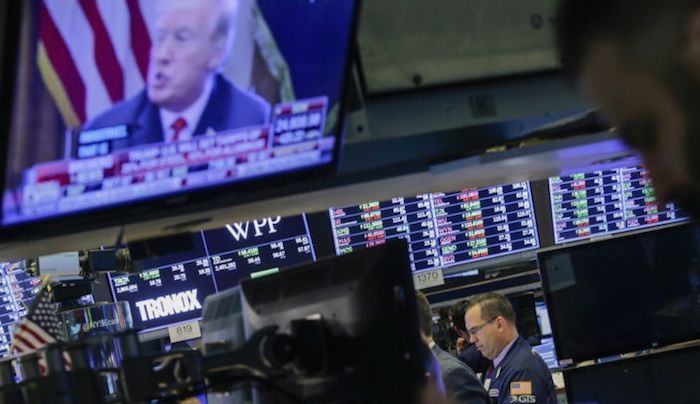Understanding The Net Asset Value (NAV) Of The Amundi Dow Jones Industrial Average UCITS ETF (Distributing)

Table of Contents
What is Net Asset Value (NAV)?
Net Asset Value (NAV) represents the net value of an ETF's assets minus its liabilities, per share. Essentially, it's the value of what you would receive if you liquidated all the ETF's holdings and subtracted its expenses. For the Amundi Dow Jones Industrial Average UCITS ETF (Distributing), understanding the NAV provides a snapshot of the underlying value of your investment, reflecting the performance of the Dow Jones Industrial Average. This article aims to provide a clear understanding of how this NAV is calculated and what factors influence it.
What is the Amundi Dow Jones Industrial Average UCITS ETF (Distributing)?
The Amundi Dow Jones Industrial Average UCITS ETF (Distributing) is an exchange-traded fund designed to track the performance of the Dow Jones Industrial Average (DJIA). This means it aims to mirror the returns of the 30 large, publicly traded companies that make up this renowned index. As a UCITS (Undertakings for Collective Investment in Transferable Securities) ETF, it adheres to stringent European Union regulations, ensuring investor protection. Importantly, it's a distributing ETF, meaning it pays out dividends to its investors periodically from the dividends earned by its underlying holdings. Key features relevant to NAV include its underlying assets (the 30 Dow Jones stocks) and a relatively low expense ratio, impacting the overall NAV calculation.
How is the NAV of the Amundi Dow Jones Industrial Average UCITS ETF (Distributing) Calculated?
The NAV of the Amundi Dow Jones Industrial Average UCITS ETF (Distributing) is calculated daily, typically at the close of market hours. The process involves several key steps:
- Market Value of Underlying Assets: The primary factor is the total market value of the 30 stocks comprising the Dow Jones Industrial Average. This is determined by multiplying the share price of each stock by the number of shares held by the ETF.
- Accrued Income: Any dividends received from the underlying stocks are added to the total asset value. This accrued income contributes positively to the NAV.
- Expenses: The ETF's operating expenses, including management fees, are subtracted from the total asset value. These expenses reduce the NAV.
- Division by Outstanding Shares: The resulting net asset value is then divided by the total number of outstanding ETF shares to arrive at the NAV per share.
This calculation utilizes reliable market data from reputable providers to ensure accuracy and transparency. The frequency of NAV calculation (daily) provides investors with up-to-date information about the fund’s performance.
Factors Affecting the NAV of the Amundi Dow Jones Industrial Average UCITS ETF (Distributing)
Several factors influence the daily fluctuations in the NAV of this ETF:
- Dow Jones Industrial Average Performance: The primary driver is the overall performance of the Dow Jones Industrial Average itself. Positive index movement generally leads to a higher NAV.
- Underlying Stock Value Changes: Individual stock price changes within the DJIA directly impact the NAV. A strong performance by one or more component stocks will boost the NAV.
- Currency Fluctuations: Although the DJIA is US dollar-denominated, currency fluctuations could impact the NAV if a significant portion of the ETF's holdings are in other currencies.
- Dividend Payouts: After a dividend distribution, the NAV will typically decrease as the distributed income is no longer part of the ETF's assets. However, this reflects a return to investors rather than a loss of value.
- Corporate Actions: Corporate actions such as stock splits, mergers, or acquisitions involving the underlying companies can influence the NAV, requiring adjustments to the ETF's holdings and calculations.
The ETF share price generally tracks the NAV closely, though minor discrepancies might occur due to trading volume and market demand.
Where to Find the NAV of the Amundi Dow Jones Industrial Average UCITS ETF (Distributing)?
Investors can find the daily NAV updates for the Amundi Dow Jones Industrial Average UCITS ETF (Distributing) through several reliable sources:
- Amundi Website: The official website of Amundi, the ETF provider, is the most accurate source for this information.
- Financial News Websites and Platforms: Many reputable financial news websites and trading platforms display real-time or delayed NAV data for ETFs.
- Brokerage Account Statements: Your brokerage account will typically show the current NAV of the ETF in your portfolio holdings.
Regularly checking the NAV allows you to monitor your investment's performance and make informed decisions about your portfolio allocation.
Conclusion: Understanding NAV and Investing in the Amundi Dow Jones Industrial Average UCITS ETF (Distributing)
Understanding the Net Asset Value (NAV) is crucial for successful investing in ETFs like the Amundi Dow Jones Industrial Average UCITS ETF (Distributing). This article has highlighted the NAV calculation process, the key factors influencing it, and how to access this important data. By monitoring NAV changes and understanding their implications, investors can track their investment performance more effectively and make informed decisions regarding their portfolio management strategy. Understanding the Net Asset Value is crucial for successful investing. Learn more about the Amundi Dow Jones Industrial Average UCITS ETF (Distributing) and start making informed decisions today!

Featured Posts
-
 Financing Your Escape To The Country Practical Tips
May 24, 2025
Financing Your Escape To The Country Practical Tips
May 24, 2025 -
 Amundi Msci World Ii Ucits Etf Dist Net Asset Value Nav Explained
May 24, 2025
Amundi Msci World Ii Ucits Etf Dist Net Asset Value Nav Explained
May 24, 2025 -
 Inside Ferraris First Official Bengaluru Service Centre A Comprehensive Look
May 24, 2025
Inside Ferraris First Official Bengaluru Service Centre A Comprehensive Look
May 24, 2025 -
 Auto Legendas F1 Motorral Szerelt Porsche Koezuti Verzioja
May 24, 2025
Auto Legendas F1 Motorral Szerelt Porsche Koezuti Verzioja
May 24, 2025 -
 Best And Worst Days To Fly For Memorial Day Weekend 2025
May 24, 2025
Best And Worst Days To Fly For Memorial Day Weekend 2025
May 24, 2025
Latest Posts
-
 Amsterdam Stock Market Three Days Of Significant Losses Totaling 11
May 24, 2025
Amsterdam Stock Market Three Days Of Significant Losses Totaling 11
May 24, 2025 -
 Dazi E Mercati L Unione Europea Pronta A Reagire Alla Crisi
May 24, 2025
Dazi E Mercati L Unione Europea Pronta A Reagire Alla Crisi
May 24, 2025 -
 Dutch Stocks Continue Downturn As Trade War With Us Heats Up
May 24, 2025
Dutch Stocks Continue Downturn As Trade War With Us Heats Up
May 24, 2025 -
 Le Borse Crollano A Causa Dei Dazi La Risposta Decisa Della Ue
May 24, 2025
Le Borse Crollano A Causa Dei Dazi La Risposta Decisa Della Ue
May 24, 2025 -
 Guerra Dei Dazi Impatto Sulle Borse Europee E Reazioni Ue
May 24, 2025
Guerra Dei Dazi Impatto Sulle Borse Europee E Reazioni Ue
May 24, 2025
